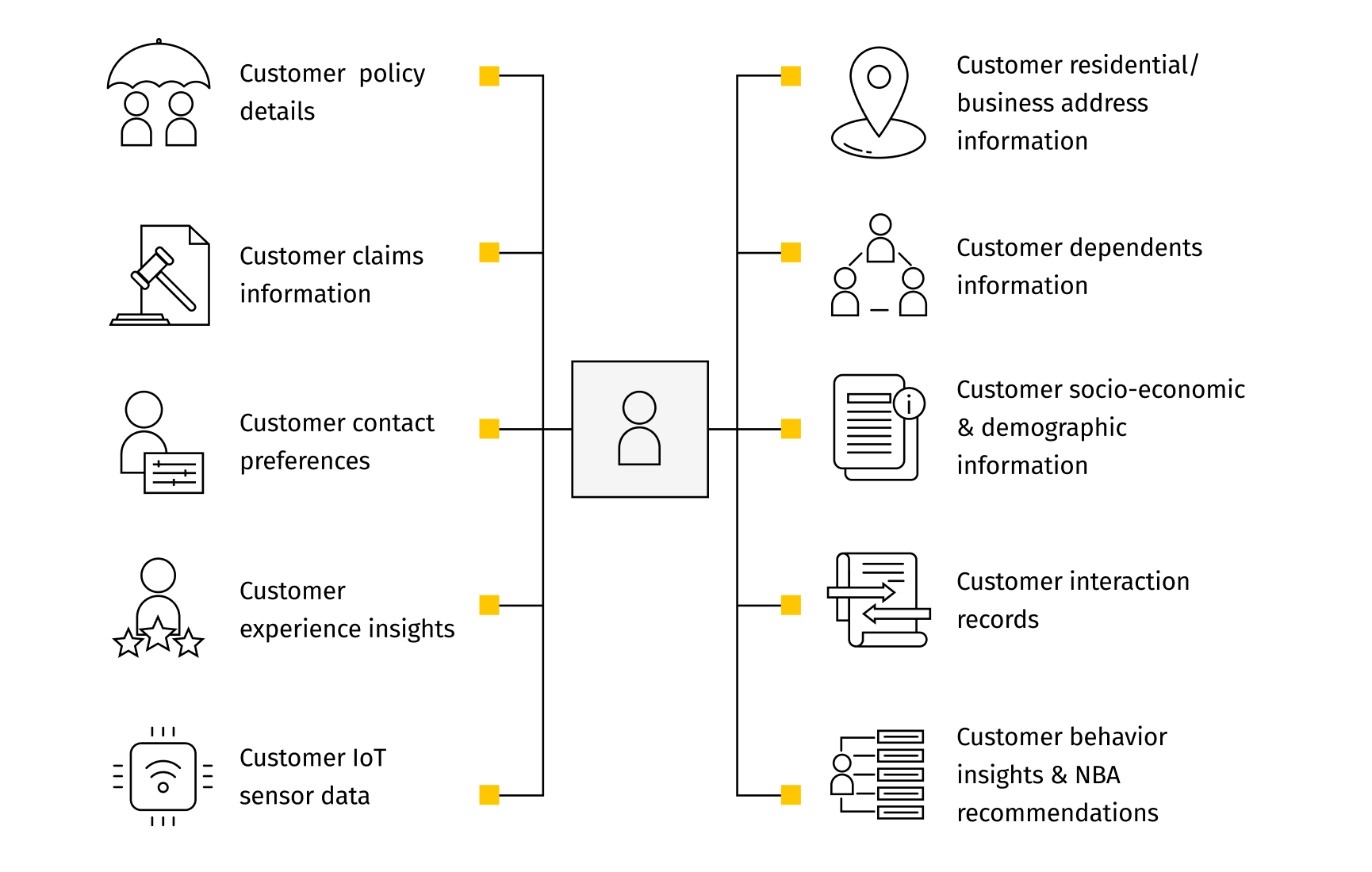
Enhance customer 360° views in insurance with predictive analytics and AI in the cloud
When it comes to insurance, customers don’t want to feel like their claim is just another drop in the ocean. This presents insurance companies with a monumental task: how to offer a tailored, user-friendly experience that fits each customer’s needs? Especially given that insurance companies have tens of thousands of claims to process on a daily basis. This is where technology comes in handy: by unlocking the potential of artificial intelligence (AI) in the cloud, insurance companies can enhance customer 360° views and offer better service to their customers.
According to IBM, 81% of insurers have integrated cloud-based technology into their claims management systems, and over one quarter now exclusively rely on the cloud to handle their data. Predictive analytics gleans useful data from internal sources, customers, and third-party sources. By doing so, insurance companies are able to not only paint a unique picture of each customer, but also process a larger amount of claims more quickly, stay ahead of fraud and risk management, and increase profits over time.
What is a customer 360° view and why is it important for the Insurance industry?
In the age of big data, not all information is created equal. Embracing a customer 360° mindset allows insurance companies to consolidate, clean, validate, and enrich customer data. The end result is a clearer, fully-fledged view of each customer and their needs. An automated, omnichannel approach to filing claims or lodging complaints, where customers can use their preferred channels and devices, also means that there is less likelihood of a hassle to the entire process. What’s more, customers are more likely to have a clearer understanding of their insurance policy details, hence avoiding any issues which might lead to a claim being denied.
Some defining characters of a customer 360° view might include, but are not limited to:
- Customer policy details;
- Previous claims;
- Dependents, if any;
- Socio-economic and demographic data;
- Interaction records; or
- Behavior insights/recommendations.
These details are drawn not only from internal sources but customer interactions and third-party sources. Customer intelligence is becoming increasingly vital for the insurance industry today. With a customer 360° view, insurance companies not only deliver better customer service but better risk management and underwriting. As such, insurance companies can shift some of their focus to core business growth and innovation.

Making the most out of customer intelligence
Typically, insurance companies possess a basic set of information garnered from customers after they request a quote, pay their premium, or file a claim. This initial set of data usually does not provide enough insight to establish a customer 360° view. However, by collecting other important data, such as from the insurance company’s call center, social media channels, mobile apps, and so on, insurance companies, through the use of machine learning and predictive analytics, can begin to craft a more in-depth portrait of their customers’ behavior and needs.
Optimize legacy data
Insurance companies already have plenty of useful information which shapes their understanding of customers. This should offer some reassurance–after all, a customer 360° view isn’t created from scratch. However much of this data is located in disconnected tech stacks throughout the enterprise. Streamlining and democratizing this data so it’s available to the claims department, underwriters, third-party vendors and everyone else within the organization will make the entire process far more efficient.
Benefits of AI for the insurance industry
The ability to achieve a customer 360° view relies on the extent to which insurers adopt technologies that process larger amounts of data in a shorter amount of time. Leveraging artificial intelligence (AI) to drive value in the cloud drives value for both the insurer and customer by predicting risks and significantly reducing underwriting errors. What’s more, it helps to provide a streamlined customer experience and optimize offers. McKinsey predicts that advanced solutions can bring in more than $1 trillion in additional value for insurers.
So how can it be done? Let’s go over some of the essential features.
Handling insurance claims with AI
An AI-powered automated claims handling system is the best protection against simple human error at best or deliberate fraud at worst. When it comes to claims administration, integrating AI and machine learning into the process enables a dedicated analysis of insurance claim data to strengthen fraud detection and prevention.
With the ability to process data at a much faster rate than the average employee, AI-powered claims handling can easily verify if a claim matches a customer’s policy before going ahead and finalizing it in the system. This removes a lot of hassle for both the insurance company and customers alike, as it accelerates and streamlines the process significantly.
Using AI in insurance underwriting
With cloud-based data collection and AI-powered analytics in particular, underwriters have access to a larger volume of high-quality information that helps them better assess risk and meet customer needs. Automating the workflow, predicting risk, optimizing pricing, and collecting more relevant information at a faster rate all combine to augment the underwriting process, reduce operating costs, generate premiums that exceed losses and expenses, increase the policyholder surplus and the capacity to issue more policies.
If we look at the key building blocks of the end-to-end underwriting journey, we can easily see how AI in the cloud can be beneficial:
- Insurance portfolio piloting: Predictive analytics can provide a forward-looking assessment to understand risk exposures and identify where the portfolio plan needs to change to profitably underwrite potential risk.
- Premium pricing optimization: With elasticity modeling and an analytics-driven workflow in the cloud, it is easier to perform price optimization by analyzing a wide range of industry signals, prevailing market dynamics and common exposures within a portfolio over time.
- Risk assessment: Combining data from a diverse range of sources, including geolocation and Internet of Things (IoT) analytics in the cloud helps underwriters assess risks more consistently and accurately.
AI-powered customer experience
According to a 2021 PwC report, implementing AI-powered customer service is becoming one of the most important keys to success in the insurance industry; around 65% of companies could already note a positive difference.
Consumer behavior and the demand for personalized customer experience requires a shift in insurance marketing and distribution models. As more consumers embrace digital channels to shop, view, compare and communicate with service providers, more opportunities for insurance companies to collect and analyze customer data become available. By collecting and combining data from your call center, mobile application, chatbot, website, and social media channels, and running the data through AI processes in the cloud, insurers can have a 360° view of every customer that enables them to provide better end-to-end customer service with insight into their needs, preferences and potential problems.
Your commercial teams will have the knowledge on how to engage meaningfully with customers with insights into their behavior, likes and dislikes, and preferred methods of communication, and it will help you develop predictive analytics that inform insurance product development and data-driven marketing campaigns for more cross- and up-sell opportunities.
360 view customer Insurance with AI: Conclusion
In today’s highly digitized world, the point where human intellect and artificial intelligence intersect offers boundless possibilities. Insurance companies that wish to grow their core business without losing sight of customer needs can adopt an automated, omnichannel approach to filing claims and lodging complaints. Through the use of predictive analytics and AI in the cloud, they can offer a service to customers that is not only more efficient but highly personalized.
Grid Dynamics is a digital-native technology services provider that accelerates growth and bolsters competitive advantage for Fortune 1000 companies. We have more than 15 years of experience in digital transformation and software innovation, most notably open source cloud-native programs.
Still have questions about 360° customer views and AI in the insurance industry and how to make it a reality? We’d love to hear from you!
